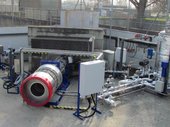ESA test opens way to UK
spaceplane engine
investment
16 July 2013
The UK government has
announced plans to
invest in the
development of an
air-breathing rocket
engine – intended for a
single-stage-to-orbit
spaceplane – following
the ESA-managed
feasibility testing of
essential technology.
The £60 million
investment, provided
through the UK Space
Agency, will back
technical improvements
leading to construction
of a prototype
Synergistic
Air-Breathing Rocket
Engine, or SABRE.
Designed by UK
company Reaction Engines
Ltd, this unique engine
will use atmospheric air
in the early part of the
flight before switching
to rocket mode for the
final ascent to orbit.
The concept paves the
way for true spaceplanes
– lighter, reusable and
able to fly from
conventional runways.
Reaction Engines
plans for SABRE to power
a 84 m-long pilotless
vehicle called Skylon,
which would do the same
job as today’s rockets
while operating like an
aeroplane, potentially
revolutionising access
to space.

Precooler
testing for
SABRE engine
The investment
decision followed the
success of ESA-managed
tests of a key element
of the SABRE design, a
precooler to chill the
hot air entering the
engine at hypersonic
speed, in Reaction
Engines’ Oxfordshire
headquarters back in
November 2012.
“Ambient air comes in
and is cooled down to
below freezing in a
fraction of a second,”
explained Mark Ford,
head of ESA’s propulsion
section. “These types of
heat exchangers exist in
the real world but
they’re the size of a
factory.
“The key part of this
is that Reaction Engines
has produced something
sufficiently light and
compact that it can be
flown.
“The idea behind the
engine is that the
vehicle flies to about
Mach 5 in the lower
atmosphere using
airbreathing before it
switches internal liquid
oxygen for the rest of
its flight to orbit.
“At that speed, the
air is coming in
extremely fast. You need
to slow it down in order
to burn it in the
engine, and doing so
will raise the
temperature of the air
to about a thousand
degrees, which can
exceed engine material
temperature limits.
“Hence the concept of
the precooler is to cool
the air down to a
temperature that is then
usable by the engine.
The idea has been
around since the 1950s
but this is the first
time anyone has managed
to achieve a working
system. Nobody else has
this technology, so
Europe has a real
technological lead
here.”